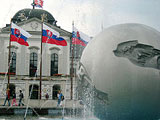Stoking Ethnic Fires in Central Europe
By Jeremy Druker for ISN
Last week, unknown assailants threw two Molotov cocktails at the Slovak embassy in Budapest, luckily neither of which exploded . A day later, two men tried to force the car of the Slovak ambassador to Hungary off the road, allegedly hurling insults, including a reference to the diplomat’s nationality.
The immediate spark for the recent events was the planned visit of Hungarian President Laszlo Solyom to the largely ethnic Hungarian city of Komarno in southern Slovakia on 21 August. Local organizers had invited the president to unveil a statue of Stephen I, the first king of Hungary.
But in defiance of EU statutes governing freedom of movement, Slovak officials barred Solyom from entering the country, saying he had chosen an insensitive day for the trip, a day that would supposedly inflame nationalist tensions.
The reference was to the anniversary of the Warsaw Pact invasion of Czechoslovakia in 1968, which had included Hungarian troops. However, few analysts took that excuse as a valid reason, believing that few Slovaks would actually make the connection and take offense.
More likely, Slovak politicians, such as the populist Prime Minister Robert Fico, saw a chance to score points with a subsection of conservative, nationalistic voters - people afraid of “the dangerous irredentism that increasingly breathes on us from across the Danube,” as Fico once put it.
Solyom has also been one of the prominent opponents of the widely debated new Slovak state language law that will take effect on 1 September. In places where an ethnic minority comprises than less 20 percent of the population, the use of a minority language in official communication could soon lead to a fine of up to € 5,000 ($7,100).
Some Slovaks may still smart over Hungary’s long rule over their territory and long-ago attempts to impose the Hungarian language and culture. And some Hungarians may still fret over the fate of the ethnic Hungarians that ended up on the other side of the country’s borders after World War I.
Left to their own devices, such nationalists would likely fade into irrelevance, similar to their French and German counterparts who eventually had little to offer to mainstream voters hoping to forget history and move on.
A recent trip by Slovak journalist Martin Simecka, for example, to southern Slovakia revealed an ethnic Hungarian population at home in Slovakia and at peace with their neighbors. Writing in the Czech weekly Respekt, Simecka found people blaming politicians for stoking inter-ethnic enmity.
While relations in the post-independence era have had their ups and downs, things turned definitely for the worse in 2006, when a populist-nationalist coalition replaced a more tolerant government that had included an ethnic Hungarian party. The ruling party, Fico’s Smer, decided to team up with the Slovak National Party and its infamous leader, Jan Slota.
So far, both the European Commission and the Swedish EU presidency have preferred to stay on the sidelines and to let the matter be handled bilaterally. Perhaps Brussels is confident that NATO allies and fellow members of the EU would never allow such a petty conflict to explode into widespread violence.
That is a risky approach. While a Balkan-style, ethnic conflict may be out of the question, the continued escalation of rhetoric could further embolden the extremist fringes and lead to attacks with Molotov cocktails and other weapons that actually work.
Just ask the Roma. Six members of Hungary’s largest minority have been murdered since last November, the likely victims of racially motivated attacks.

